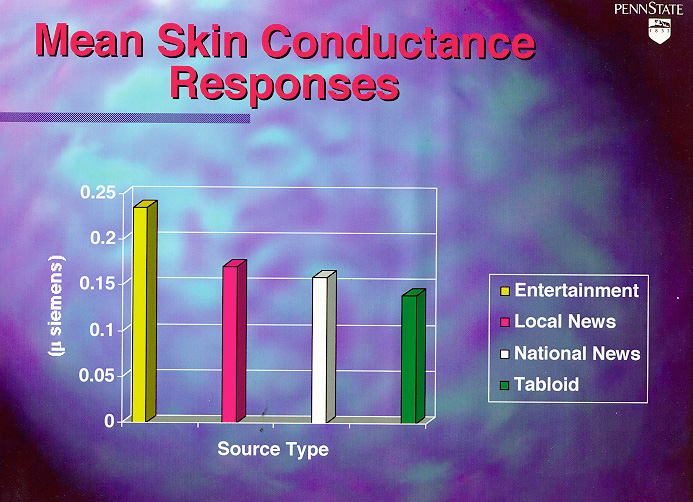Media Effects Research Lab - Research Archive
Source perception and electrodermal activity
Student Researcher(s)
Nokon Heo ( Candidate);
Faculty Supervisor
FOR A COMPLETE REPORT OF THIS RESEARCH, SEE:
Heo, N., & Sundar, S. S. (1998, July). Source perception and electrodermal activity. Paper presented to the Communication Theory & Methodology division at the annual conference of the Association for Education in Journalism and Mass Communication (AEJMC), Baltimore, MD.
INTRODUCTION
The psychological effects of communication sources have been extensively studied by scholars in communications, advertising, political communications, and psychology. However, little is known about perception of sources as a function of emotional states of receivers. This study measured the emotional impact of communication sources on television viewers, and examined whether there is a systematic association between receivers' emotional states and their perception of communication sources. The emotional state examined in this study is autonomic arousal, as measured by electrodermal skin conductance responses (SCRs). Theory and research from the Multistage Sequential Model of Face Recognition were used to propose a set of hypotheses linking viewers' arousal as well as their perceptions upon viewing television sources.
HYPOTHESES
H1a: Different sources will elicit different levels of skin conductance responses (SCRs).
H1b: Sources identified with different genres of television programs will elicit different levels of SCRs.
H2: Familiar sources as compared to less familiar sources will elicit greater arousal (SCRs).
H3: The more likable a source, the greater the arousal.
H4: The more attractive a source, the greater the arousal (SCRs).
METHOD
Twenty-eight participants viewed 22 six-second clips showing facial images of newsmakers, game show hosts, entertainment hosts, and celebrities.
Source perception was measured on a paper-and-pencil questionnaire administered after each source. Electrodermal activity, recorded during exposure to each of the 22 sources, was operationalized as the amplitude of the largest SCR during the six-second periods.

RESULTS

H1a: Supported. Different communication sources elicited different levels of skin conductance responses (SCRs).
H1b: Supported. Different types of sources elicited different levels of skin conductance responses (SCRs).
H2 and H3 : Supported. Sources perceived as familiar and likable elicited greater levels of arousal (SCRs).
H4 : Not supported. Source attractiveness was not associated with skin conductance responses (SCRs).
CONCLUSIONS
Theoretically, there appear to be physiological correlates to reception of communication sources. Methodologically, electrodermal activity is indicative of perceptual direction. Practically, the results provide a physiological basis for classifying media sources along such receiver-based criteria as perceived familiarity and likability.
For more details regarding the study contact
Dr. S. Shyam Sundar by e-mail at sss12@psu.edu or by telephone at (814) 865-2173

